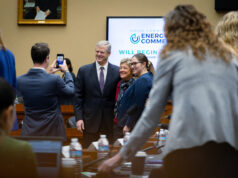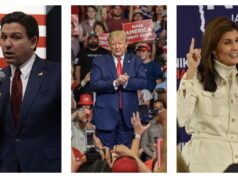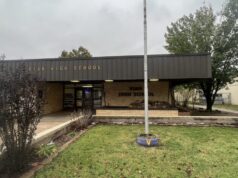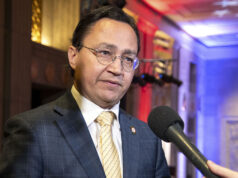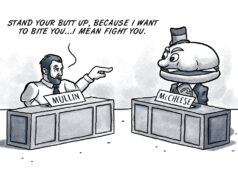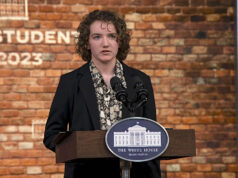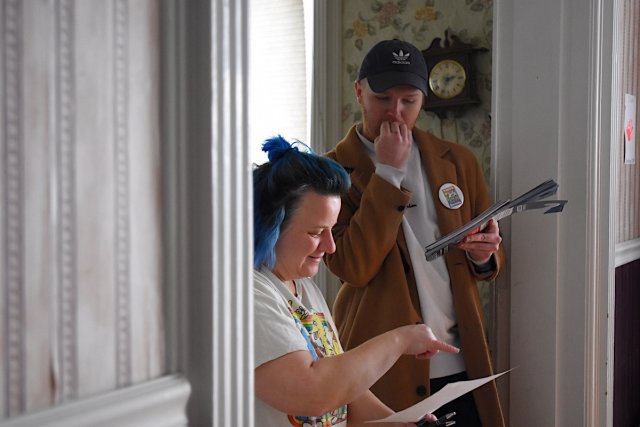

CLARINDA, Iowa — Inside “Grandma’s House,” a Bernie Sanders sign rested on an air mattress shoved into an alcove near the front door. The dining room, which had been reserved for strategizing, was now in disarray. So were the upstairs bedrooms.
As 10 Oklahomans assembled on a worn couch, the only working lamp in the living room flickered.
“It’s Grandma’s spirit trying to communicate,” someone said dryly.
For four days, they had stayed in Omaha, Nebraska, across the river from Council Bluffs, Iowa, to canvas for Democratic presidential candidate Sen. Bernie Sanders (D-VT).
This story was reported by Gaylord News, a Washington reporting project of the Gaylord College of Journalism and Mass Communication at the University of Oklahoma.
“Grandma’s House” was the affectionate nickname for their headquarters, a three-story, cherub-themed Airbnb.
“The national campaign is really pushing people from other states to really hit the early states like Iowa, South Carolina and Nevada,” said Corey Abernathy, 23, who studied political science at the University of Oklahoma. “They call it a Bernie journey.”
All team members were either Millennial or Gen Z, and most were from Norman. They had been all over southwestern Iowa, knocking doors for the Feb. 3 Iowa Caucuses, when constituents will gather to discuss and vote on candidates.
“(Sanders) inspired my generation out of passivity,” said Caleb Farris, 25.
Husband and wife Caleb and Ashley Creed, 33 and 30, contacted local activists and organized the trip.
“It just organically accumulated because there’s just a lot of energy in the campaign,” Caleb Creed said.
Among the canvassers were software engineers, college students and a stay-at-home mother.
Alejandro Vaca, 35, an Ecuadorian fashion designer, said Sanders supporters share similar values. Darcie Woodson, 35, has been with the campaign since 2015 and said these values are based on empathy.
“I think that’s also what helps you get along with various people from various walks of life,” Woodson said.
And this held true in the field, said Mike Smith, 41, as he recalled visiting with a Trump supporter:
“(The Trump supporter) was like, ‘I am a staunch Republican, but there’s no reason to be a jerk to you guys just because you’re for Bernie,'” said Smith. “And I was like, yeah. And so I talked about being from Oklahoma. He said he was going to do some racing down there this year. So in other words, we had a very human exchange.”
Some, like Phillip Sipe, 31, were once Republicans themselves.
“I’ve been ideologically sort of shifting to the left over time,” Sipe said. “I grew up in a house that was very conservative. Every day was like Fox News, Glenn Beck, Bill O’Reilly.”
Oklahoma has voted for the Republican presidential candidate in every election since 1968. But the state has strong populist — and in turn, socialist — roots. Even now, the state motto is “Labor Omnia Vincit,” which translates to “labor conquers all.”
“It’s a very leftist and agrarian revolt themed idea,” said Caleb Farris, who studied populism at OU.
‘We all share similar wants and needs’
Populism, born out of corporate mistrust, arrived in 1889 and 1890 to what would later become Oklahoma. Soon, Oklahoma populists became affiliated with either the Democratic Party or the Socialist Party. By 1910, more socialists were registered per capita in Oklahoma than in New York state.
Now, historians say the last decade was characterized by populist movements on both the right and left, some fueling the development of conservative coalitions like the Tea Party, some fueling grassroots movements like Occupy Wall Street. In Oklahoma’s case, Farris said populist heritage is front and center.
“It’s definitely the feeling of what’s real, of sticking to what you’ve always believed,” Farris said. “Trump didn’t win in the primary here. Ted Cruz did.”
Although former Vice President Joe Biden was polling No. 1 in Oklahoma in July, 2019, Oklahomans had donated about $1.1 million to the Sanders campaign as of the beginning of this year, according to campaign filings with the Federal Election Commission. That’s more than double the total donation amounts for fellow candidate Elizabeth Warren, who grew up in Oklahoma City and Norman. In the 2016 Democratic Primary, Sanders swept 75 of Oklahoma’s 77 counties, winning many of the state’s rural, deeply conservative areas.
“Whenever I talk to voters or conservatives, we all share similar wants and needs and passions, but because it’s painted blue or red or socialist, all of a sudden people step away,” Farris said.
Around 11 a.m., the 10 Oklahomans meandered out the door of Grandma’s House. Three would go to Iowa for one last day of door knocking, but most were headed back to the plains.
Sitting in an upstairs bedroom, Farris reflected on his home state. With the primary and election approaching, he said Oklahomans of all ideologies should demonstrate one of their most deeply held principles: brotherly love.
“Especially in Oklahoma, it’s all about being polite, saying ma’am and sir, and looking out for each other,” he said. “Even if we do take personal rights very seriously, Oklahomans are nothing without a neighbor.”










